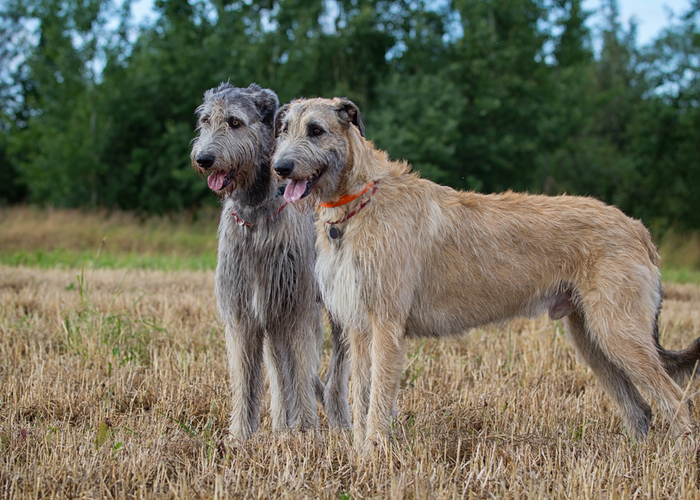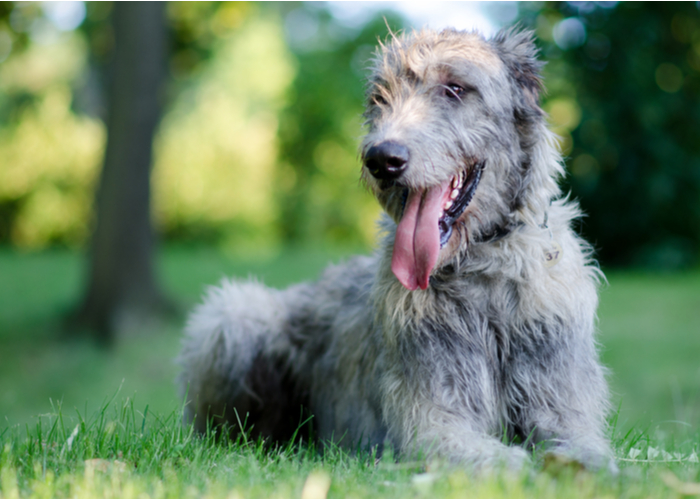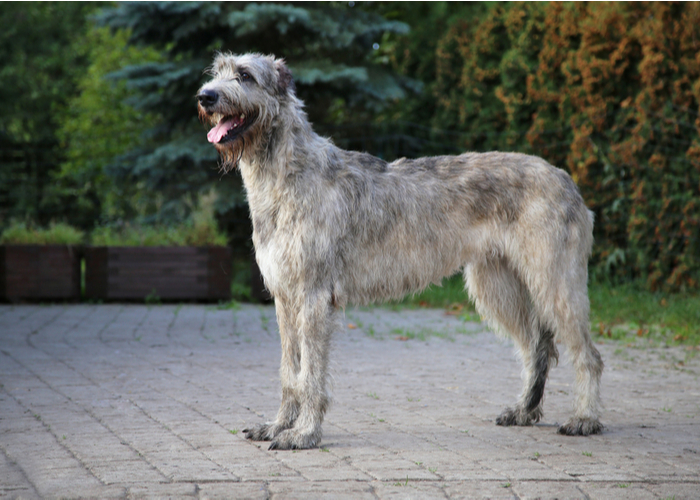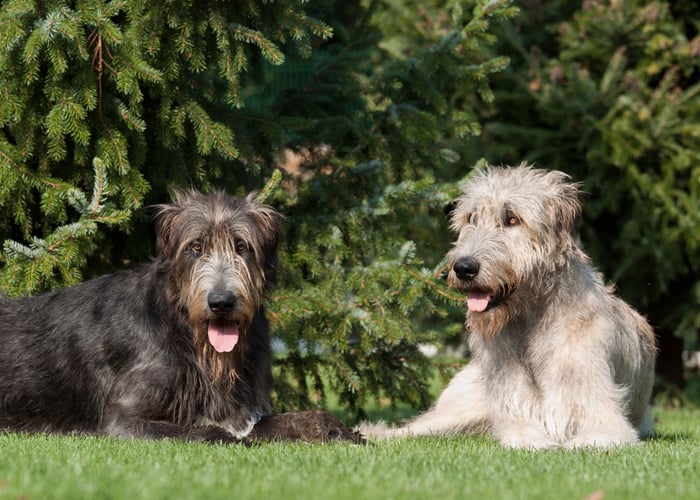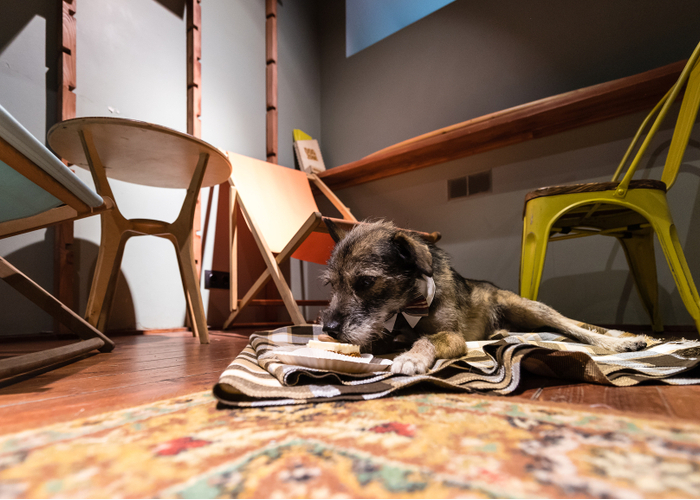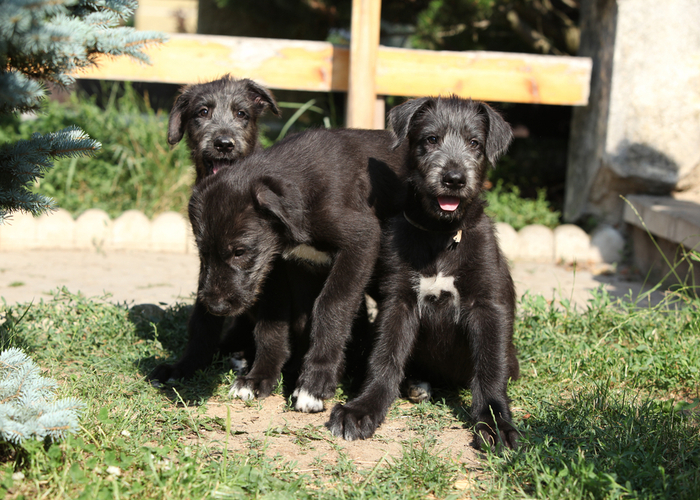Table of Contents
- What is Irish Wolfhound? – One of the World's Biggest Dog
- Irish Wolfhound Dog Main Qualities
- Irish Wolfhound Physical Appearance
- Irish Wolfhound Lifespan
- What to Feed Your Irish Wolfhound
- Caring an Irish Wolfhound
- Common Health Issues of your Irish Wolfhound
- Irish Wolfhound Puppies and Dogs, Where to Find One
- Irish Wolfhound Historical Background
- Irish Wolfhound: Final Thoughts
They are courageous hunters and the present record holder of the longest tail dog breed title of the Guinness World Record. But more than that, they're as kind and as precious as their size. Meet the Irish wolfhound dog breed – one of the world's biggest dogs with a giant heart!
This wolfhound dog breed might not be as attractive as other dogs, but they have a gentle and impressive talent that makes them highly desirable.
If you're looking to learn more about their:
- Characteristics, personality, and appearance
- Historical background and average lifespan
- Common health issues and prevention tips and mitigation
You came to the right place.
With this article, you'll be able to see the pros and cons of raising this type of majestic dog breed.
So, join us as we discuss further the beauty of the Irish Wolfhound.
What is Irish Wolfhound? – One of the World's Biggest Dog
An Irish Wolfhound dog has been a dignified, calm, and courageous dog breed for decades. They are well known for their wild animal hunting skills and are believed to be the descendants of the Greyhound.
This Wolfhound might be giant, but it has immense affection for its family. They are once used in ancient wars to drag soldiers off to their horses and chariots.
Their muscular strength enables them to jump and hop in the hunting ground to catch boar, wolves, and deer. Now, they don't only focus on hunting activities. They're also one of the best companions you can ever have.
Let's know more about the true personality of this Irish Wolfhound.
Irish Wolfhound Dog Main Qualities
This Irish Wolfhound has a heart as massive as its size. They are gentle, easygoing, kind, and noble, but sometimes they show sensitivity but can handle it.
This dog is friendly for both kids, dogs, and even strangers.
Like other dog breeds, Wolfhound doesn't tolerate being left alone at your home because it makes them distracted.
So, you must ensure that you have a family member that'll accompany them. Or else you should bring them wherever you go.
It may be hard to manage them if you're a first-time dog parent. But regular training and bonding with them will help you build a strong relationship.
Because their immense size requires a spacious place, apartment living is not suited for them.
Other breeds with short coats can catch a cold, but this Irish Wolfhound could tolerate cold. However, they're prone to overheating.
Irish Wolfhound Physical Appearance
The physical appearance of this breed may not be as visually appealing as other furry dog breeds, but their physique is built for something great.
Now, let's learn more about their physical attributes and know why you'd better consider them as a new addition to our family.
Body
The body form of this Irish Wolfhound is similar to that of a Greyhound, but they're different breeds. This Wolfhound's body is proportionate to its other body parts but has a broad and deep chest.
What makes them adorable is their body coats. They have rough and rugged skin that helps them endure the cold seasons.
And it's wiry and long, especially over their eyes and under their jaw. Their coats have different variations:
- Grey – sometimes they call it blue
- Brindle – can be a combination of two or three colors, such as black, white, or red.
- Red – it is a red shade color but not the red color itself
- Black – a solid color
- White
- Fawn
- Wheaten
But their colors also depend on what color is dominant to their parents when they are bred.
Tail
The tail of this Irish Wolfhound is long. That explains why they're the record holder of Guinness World Record. They also have a wiry and long coat, the same with their body.
Height and Weight
As the tallest dog breed, this Irish Wolfhound has astounding height. They could have an average size of up to 32 inches for the males and 30 inches for the females.
So they could sit as high as you.
Their weight could range up to 120-155 pounds for the males, while the females range from 105-135 pounds.
That mass would make it impossible to carry them once they become mature.
And now, these descriptions might help identify them from other breeds. Let's go on to the average years that they could live.
Irish Wolfhound Lifespan
You might enjoy bonding with your Irish Wolfhound, and you might wish to be with them longer. But sadly, you can't do that in many years because of their short lifespan.
This Irish Wolfhound does not live long like the other tall dogs, such as the Great Danes. Though they are known to live up to 13 years, most die earlier than that – maybe seven years or below.
According to the study conducted by the Irish Wolfhound Health Group, the average lifespan of Wolfhound is between 6-6 ½ years.
Chronic diseases and other health problems and incidents are why they have a short lifespan. That's why it's critical to groom and care for them properly.
Here are the things your Irish Wolfhound need to have longer life:
Proper Exercise
As a hunter, your Irish Wolfhound needs exercise throughout their entire life. So, early training and other physical activities will significantly help them strengthen their body as they grow.
It's indispensable to keep their body healthy and stay active and avoid any health issues.
But, it would be best if you'd choose the proper exercise for them. The physical activity your Wolfhound must do would correspond to their body strength.
Your adult Wolfhound might require vigorous activity like tracking, agility, and lure coursing, but not your Wolfhound puppies.
So you'd better let your puppies walk for a short time and let them rest.
Diet and Nutrition
Proper diet and nutrition are among your Irish Wolfhound's primary needs. It would be best to remember that you couldn't feed them with any food without knowing its benefits.
So checking the ingredients and the benefits of dog food is very crucial. If you're still unsure if the products you just bought are good, then don't hesitate to approach your vet.
What to Feed Your Irish Wolfhound
Daily feeding high-quality dog foods to your Irish Wolfhound is essential for their growth. So, an average of 4 to 8 cups of dry foods would be best for them.
But the amount of food they need also depends on their age, ability, metabolism, and energy level. So, it's imperative to keep the average weight and diet of your canine.
By doing so, your Wolfhound could alleviate the risk of bloat and some other health issues like obesity and arthritis.
According to the recent study of Tufts University, dog foods contain material that causes Dilated Cardiomyopathy. A condition that affects the heart of your Wolfhound.
So, you have to thoroughly check what dog food would be best for your Irish Wolfhound. To determine the best food for your Wolfhound, you must look for the following:
- Labels and certification
- Nutritional claims
- Company reputation and recall history
- Expiration dates
- Additives
- Questionable ingredients
- Testing and quality control, etc.
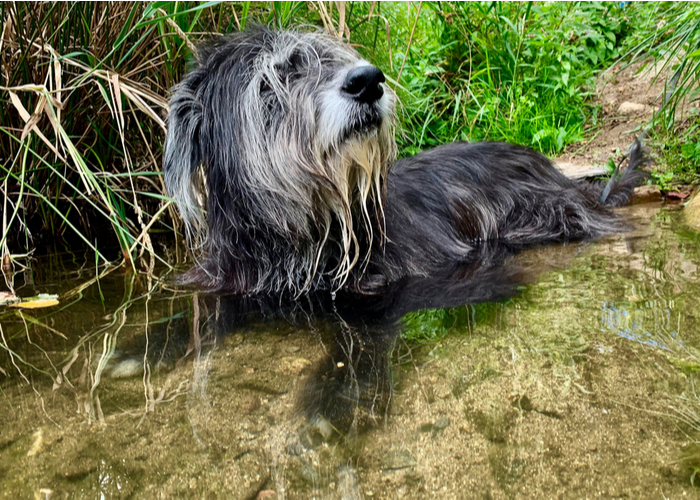
Caring an Irish Wolfhound
Aside from giving the proper diet, nutrition, and exercise for the Irish Wolfhound, a responsible owner should provide appropriate care.
Being an active housedog is also risky. Your Wolfhound could also have many injuries in its bones.
So if you're planning to adopt an Irish Wolfhound, be sure that you don't have stairs in your house.
It would be better if they could move freely in a yard every day. That would help them do some physical activities to maintain their good mental and physical health.
Your Wolfhound puppies might want to run in the yard, but they also need to rest. Just let them run for about 20 minutes, especially if they're still six months old below.
After that, if they reach adolescence, maybe they could have a long walk with you on the sidewalks.
And they also need proper grooming to maintain their good hygiene. Below are some ways to do that.
Grooming Your Irish Wolfhound
You don't have to take them a bath every day unless they smell bad. But if you'd prefer to do that, well that's not a problem.
They shed every year, but luckily, it's not excessive, and it does not blow out.
Furthermore, brushing at least once a week would be enough to remove dirt and maintain the excellent look of your Wolfhound's coat.
Trimming your Irish Wolfhounds' nails is also essential to prevent problems when they're walking and running. And that would also make them comfortable to move.
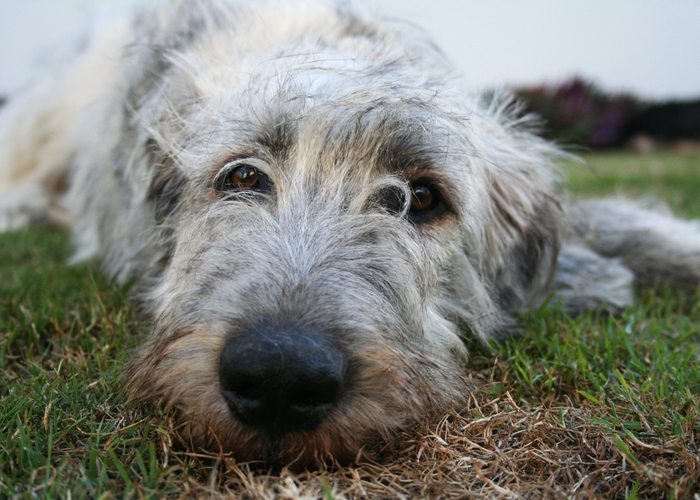
Common Health Issues of your Irish Wolfhound
Like other large dog breeds, these Irish Wolfhounds can also experience different health problems.
So, if you're trying to adopt one, you should consider the following health risks and learn some ways to prevent them.
This condition is life-threatening for all dogs. It commonly happens Wolfhound is eating faster and then doing some vigorous activities or even drinking a lot of water.
And it causes the stomach to dilate and prevents the flow of blood throughout the abdomen.
There are dog breeds that show sensitivity in injecting anesthesia because that could lead to their death.
So, to know if your Wolfhound shows signs of sensitivity, it would be better to approach your vet.
A hereditary condition that is common in all large dog breeds. It occurs when the dog's bones in the hip and elbow are not okay – meaning there's a disorder.
Mostly affected dog shows lameness and swelling, so you must take them for a regular check-up and X-rays if necessary.
It is an abnormal blood flow between the liver and other body parts. Symptoms might include lack of appetite, abnormalities in their neurobehavioral, low blood sugar, stunted growth, and many more.
This condition occurs when heart muscles become thin and unable to contract normally. It could lead to severe heart disease like heart failure.
A condition that could lead to partial or complete paralysis of the dog's legs.
Aggressive cancer on your canine's bone, which also causes lameness. It can also be seen with an X-ray.
If you've observed some signs of the different conditions on your Wolfhound, immediately take it to your vet for proper diagnosis.
Irish Wolfhound Puppies and Dogs, Where to Find One
Are you looking for a place where you can find Irish Wolfhound puppies? Throughout America, many organizations rescued and preserved the Irish Wolfhound breed.
The National Breed Club is a parent club dedicated to preserving, protecting, and advancing many dog breeds.
This club was licensed by American Kennel Club and followed their breed standards, so you can truly trust their breeders.
You can also visit the AKC's marketplace, where they posted those available Irish Wolfhound puppies in different locations.
And you can also trust them because AKC evaluates their breeding process.
If you prefer to adopt rather than buy one, below are some organizations that you can reach out to:
- Irish Wolfhound Club of America Rescue – This club is rescue volunteers assisting owners who can't care for their Irish Wolfhound anymore. They also have an adoption policy to ensure that the Irish Wolfhounds they've rescued find a comfortable and safe home.
- Irish Wolfhound Club of Canada – A non-profit organization formed to protect and advance the breed of Irish Wolfhound throughout Canada.
- Great Lakes Irish Wolfhound Association (GLIWA) – An association that seeks Irish Wolfhounds to educate and promote their breed throughout the Great Lakes area.
- Potomac Irish Wolfhound Club – Another responsible club dedicated to maintaining the health and welfare of all Irish Wolfhounds throughout the region.
So, if you're planning to add this Irish Wolfhound to your family, don't hesitate to contact those organizations mentioned above. You can contact them by visiting their websites.
Irish Wolfhound Historical Background
The Wolfhound has a long and illustrious history that dates back centuries, encrusted with myth and mythology.
However, they believed that they were developed by crossing giant British dogs with Middle Eastern.
The enormous hounds of Ireland were well established by the time the Roman Empire had a foothold in the British Isles. In 391, the Roman consul was given seven of these hounds, which “all Rome marveled at.”
Aside from being solid hunters in their time, this Irish Wolfhound also frequently appears in many poetry and legends.
For example, the poem “The Irish Greyhound” was written by Katherine Phillips in 1664. And the myth of “Gelert, the Faithful Hound” is a melancholy tale about loyalty.
As the Irish Hounds became well-known hunters, they specialized in hunting wolves in the 15th century.
But, in the late 1700s, when wolves and other big animals became extinct, the Irish Wolfhound was also nearly extinct.
Luckily, in the 1862s, George Augustus Graham, a British army captain, started preserving and protecting the Irish Wolfhound breed.
And he even makes standards to safeguard this wolf hunter's species.
Irish Wolfhound: Final Thoughts
This Irish Wolfhound descended from the Greyhound with special hunting skills. Though they're big, they also have a big personality that would surely make you love them.
So, if you need an active and best companion, consider adding this Wolfhound which came from Ireland.
However, you also have to remember that having this dog comes with a big responsibility in caring and grooming.
You need to maintain your Wolfhound's body in good condition for them to stay active.
But, overall, you would surely enjoy their company since Irish Wolfhound dogs can be the most loving and loyal dogs you could ever have.



